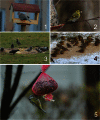Urban and rural habitats differ in number and type of bird feeders and in bird species consuming supplementary food
- PMID: 26003091
- PMCID: PMC4592493
- DOI: 10.1007/s11356-015-4723-0
Urban and rural habitats differ in number and type of bird feeders and in bird species consuming supplementary food
Abstract
Bird feeding is one of the most widespread direct interactions between man and nature, and this has important social and environmental consequences. However, this activity can differ between rural and urban habitats, due to inter alia habitat structure, human behaviour and the composition of wintering bird communities. We counted birds in 156 squares (0.25 km(2) each) in December 2012 and again in January 2013 in locations in and around 26 towns and cities across Poland (in each urban area, we surveyed 3 squares and also 3 squares in nearby rural areas). At each count, we noted the number of bird feeders, the number of bird feeders with food, the type of feeders, additional food supplies potentially available for birds (bread offered by people, bins) and finally the birds themselves. In winter, urban and rural areas differ in the availability of food offered intentionally and unintentionally to birds by humans. Both types of food availability are higher in urban areas. Our findings suggest that different types of bird feeder support only those species specialized for that particular food type and this relationship is similar in urban and rural areas.
Keywords: Central Europe; Human support; Human-wildlife interaction; Supplemental food; Urban ecosystems; Urbanization; Wintering.
Figures



Similar articles
-
Urbanization affects neophilia and risk-taking at bird-feeders.Sci Rep. 2016 Jun 27;6:28575. doi: 10.1038/srep28575. Sci Rep. 2016. PMID: 27346383 Free PMC article.
-
Winter Bird Assemblages in Rural and Urban Environments: A National Survey.PLoS One. 2015 Jun 18;10(6):e0130299. doi: 10.1371/journal.pone.0130299. eCollection 2015. PLoS One. 2015. PMID: 26086819 Free PMC article.
-
Does the sex and age of birds and the size of human settlements affect recapturing of the Great Tit (Parus major) at bird feeders?Behav Processes. 2019 May;162:162-166. doi: 10.1016/j.beproc.2019.03.007. Epub 2019 Mar 15. Behav Processes. 2019. PMID: 30885678
-
Non-linearities in bird responses across urbanization gradients: A meta-analysis.Glob Chang Biol. 2018 Mar;24(3):1046-1054. doi: 10.1111/gcb.13964. Epub 2017 Nov 23. Glob Chang Biol. 2018. PMID: 29080260
-
Behavioural responses of wildlife to urban environments.Biol Rev Camb Philos Soc. 2013 Aug;88(3):537-49. doi: 10.1111/brv.12012. Epub 2012 Dec 24. Biol Rev Camb Philos Soc. 2013. PMID: 23279382 Review.
Cited by
-
Draft Genome Sequence of a Multidrug-Resistant Strain of Salmonella enterica Serovar Typhimurium Isolated from a Pine Siskin (Spinus pinus).Microbiol Resour Announc. 2022 Nov 17;11(11):e0098222. doi: 10.1128/mra.00982-22. Epub 2022 Oct 10. Microbiol Resour Announc. 2022. PMID: 36214704 Free PMC article.
-
Habitat-related differences in song structure and complexity in a songbird with a large repertoire.BMC Ecol. 2019 Sep 18;19(1):40. doi: 10.1186/s12898-019-0255-7. BMC Ecol. 2019. PMID: 31533798 Free PMC article.
-
Urbanization, environmental stabilization and temporal persistence of bird species: a view from Latin America.PeerJ. 2018 Dec 6;6:e6056. doi: 10.7717/peerj.6056. eCollection 2018. PeerJ. 2018. PMID: 30564519 Free PMC article.
-
Darwin's small and medium ground finches might have taste preferences, but not for human foods.R Soc Open Sci. 2022 Jan 26;9(1):211198. doi: 10.1098/rsos.211198. eCollection 2022 Jan. R Soc Open Sci. 2022. PMID: 35116148 Free PMC article.
-
Urbanization and the temporal patterns of social networks and group foraging behaviors.Ecol Evol. 2019 Apr 1;9(8):4589-4602. doi: 10.1002/ece3.5060. eCollection 2019 Apr. Ecol Evol. 2019. PMID: 31031929 Free PMC article.
References
-
- Brittingham MC, Temple SA. Impacts of supplemental feeding on survival rates of black-capped chickadees. Ecology. 1988;69:581–589. doi: 10.2307/1941007. - DOI
-
- Chamberlain DE, Cannon AR, Toms MP. Associations of garden birds with gradients in garden habitat and local habitat. Ecography. 2004;27:589–600. doi: 10.1111/j.0906-7590.2004.03984.x. - DOI
-
- Chamberlain DE, Cannon AR, Toms MP, Leech DI, Hatchwell BJ, Gaston KJ. Avian productivity in urban landscapes: a review and meta-analysis. Ibis. 2009;151:1–18. doi: 10.1111/j.1474-919X.2008.00899.x. - DOI
-
- Ciach M. The winter bird community of rural areas in the proximity of cities: low density and rapid decrease in diversity. Pol J Ecol. 2012;60:193–199.
Publication types
MeSH terms
LinkOut - more resources
Full Text Sources
Other Literature Sources
Medical

